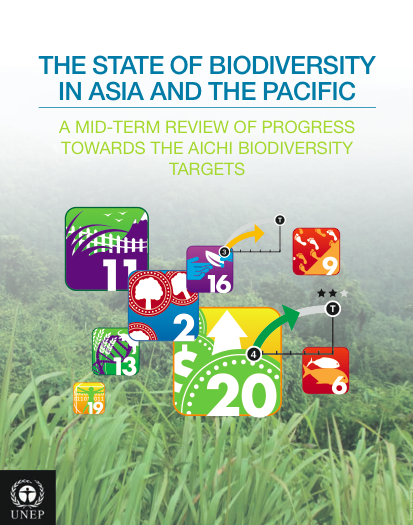
28 May, 2016
The Price of “Growth”: Asia Pacific Fast Losing its Unique Biodiversity – UNEP report
Nairobi/Bangkok, 22 May 2016 – Despite some progress in tackling growing threats to biodiversity and ecosystems on its lands, forests and waters, Asia and the Pacific is fast losing its unique flora and fauna. The rapid economic growth in the Asia Pacific region, accompanied by increased resource use by a growing urban and middle-class population is contributing to the significant pressures on the region’s biodiversity, according to a new report released by the United Nations Environment Programme (UNEP).
The State of Biodiversity in Asia and the Pacific, which was launched on the International Day for Biodiversity, celebrated ahead of the second United Nations Environment Assembly (UNEA-2) in Nairobi, Kenya, takes stock of regional progress towards a set of 20 global biodiversity goals known as the Aichi Biodiversity Targets. The report, prepared jointly by UNEP and the Convention on Biological Diversity (CBD), builds on the fourth edition of the Global Biodiversity Outlook published in 2014.
The report reveals that although progress has been made in meeting some of the 20 Aichi Biodiversity Targets, such as increasing protected areas and more policies in support of the Strategic Plan for Biodiversity 2011-2020 and Aichi Biodiversity Targets, the region still lags in meeting many of the targets set for2020.
“Looking to the future, it is clear that countries in the region need to step up their efforts towards achieving the Aichi Biodiversity Targets by significantly increasing investments to conserve biodiversity, which is the collective responsibility of our society and for future generations. These actions will also help contribute to national achievements of the Sustainable Development Goals,” said Isabelle Louis, acting Regional Director and Representative for UNEP Regional Office for Asia and the Pacific.
The report cited accelerating habitat loss as a major threat to biodiversity. Six per cent of Asia-Pacific forest cover has been lost from 2000-2013, with Southeast Asia losing 13 per cent of its forests since 1992 to industrial-scale agriculture, such as oil palm plantations. Several Asia-Pacific countries have lost between 40-55 per cent of intertidal habitats vital for migratory water birds, with the greatest loss in the Yellow Sea region, due to reclamation for urban, industrial and agricultural development. At least half of Southeast Asia’s over 270,000 km2 of tropical peat lands, which support swamp forests and unique aquatic habitats, have been drained or burned. Climate change is also adding to pressures on the region’s biodiversity.
The region also has the largest number of threatened species. Invasive alien species are responsible for the extinction of many species and one of the main causes of biodiversity loss in the region with especially devastating impact on oceanic islands. In addition, wild fauna and flora species, including marine wildlife are increasingly threatened by unsustainable wildlife trade fed by growth in demand.
The report lists regional progress towards the Aichi Biodiversity Targets. This includes increased coverage of protected areas, particularly marine and coastal protected areas although their management effectiveness still needs to be improved. The region has nearly 10 million hectares of certified forests and leads the world in marine and coastal protected areas, with 11.9 percent of marine and coastal protected areas compared to the world average of 8.4 per cent. Other areas include growing use of voluntary certification for forests and fisheries and increasing interest in trans-boundary collaboration to protect high biodiversity value areas.
The report recommends improving access to information to accurately assess the status, trends, risks, threats and conservation needs for biodiversity, mainstreaming biodiversity conservation into national and sectoral decision-making processes, establishing strong national frameworks to embed biodiversity and ecosystem services into efforts towards the attainment of the SDGs, and intensifying efforts to tackle invasive alien species.
The second edition of The State of Biodiversity in Asia and the Pacific complements the fourth edition of the Global Biodiversity Outlook (GBO-4) published by the Convention on Biological Diversity (CBD) in 2014 that assessed worldwide progress towards the ‘Strategic Plan for Biodiversity 2011-2020’ and the associated Aichi Biodiversity Targets, adopted in 2010. The State of Biodiversity in Asia and the Pacific provides an analysis of the status and trends of biodiversity in the region against the 20 Aichi Biodiversity Targets.
The United Nations Environment Assembly (UNEA) is the world’s highest decision-making body on the environment. Hundreds of key decision makers, businesses and representatives of intergovernmental organizations and civil society will gather in Nairobi on 23-27 May 2016 for UNEA-2 at the United Nations Environment Programme headquarters.
The assembly will be one of the first major meetings since the adoption of the 2030 Agenda for Sustainable Development and the Paris Climate Agreement. The resolutions passed at UNEA-2 will set the stage for early action on implementing the 2030 Agenda, and drive the world towards a better, more just future.




Liked this article? Share it!